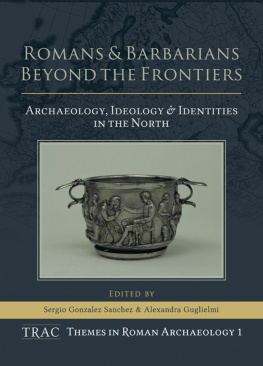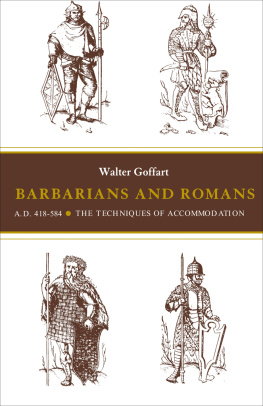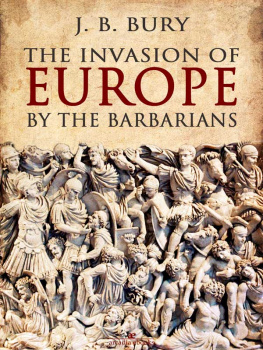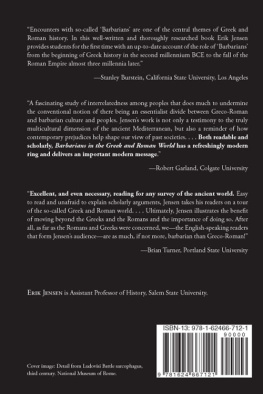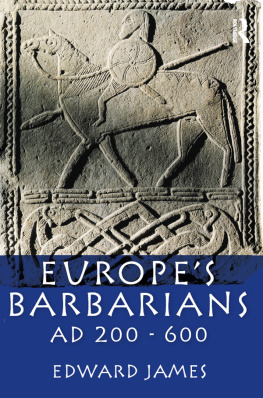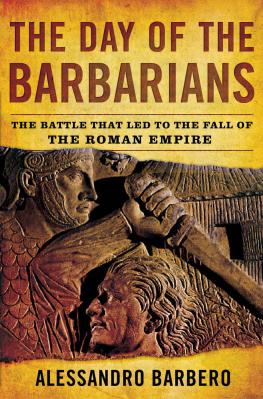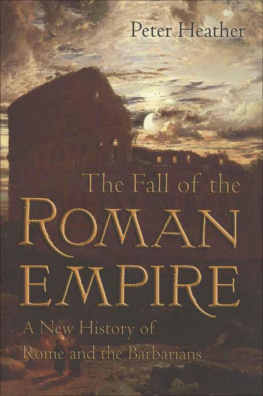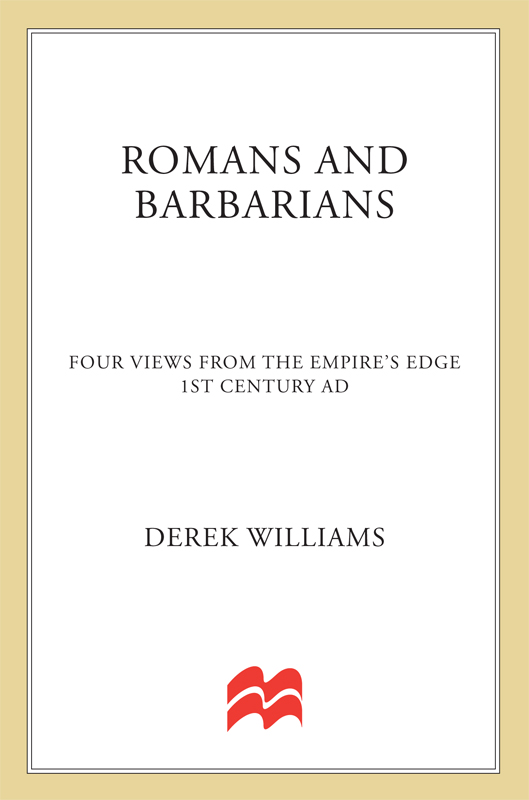Contents
Guide

The author and publisher have provided this e-book to you for your personal use only. You may not make this e-book publicly available in any way. Copyright infringement is against the law. If you believe the copy of this e-book you are reading infringes on the authors copyright, please notify the publisher at: us.macmillanusa.com/piracy.
Contents
To Matthew, Haidi and April
As with many a second book, Romans and Barbarians owes its inception to excessive zeal in writing the first. When sketches for a work on the Roman frontier (published in 1996 as The Reach of Rome ) promised to be unmarketably long, associates and colleagues (especially Dr Andrew Dalby and my literary agent, Caroline Davidson) pointed to the lands and peoples outside the imperial boundaries as valid subjects for a book in their own right. Though hesitating to accept so strenuous a challenge, it was undeniable that certain incidents arising from the Roman-barbarian connection were rich in interest; and that, rather than forgo the fruits of long study, the best of them could be shaped into a second book of less studious but more human character. Owing to historical chance and the even more haphazard accidents of textual transmission (by which some accounts of ancient history survived the centuries, but so many did not), several of the most memorable events fell into a group approximating to the 1st century of the Christian era. This served both to limit the canvas and offer the unity of a single period: that of the first ten caesars, when Romes power reaches its zenith, and dominance over the outside world, begins, almost imperceptibly, to slip.
These two collaborators, then, are the first to be thanked. I acknowledge the assistance of a distinguished philologist, Anna Partington, who advised on a variety of origins and meanings. It is my loss that she was not consulted till the eleventh hour, when the books closing date was drawing near. I am also grateful to Samantha Hopkins for typing the text, to Alexander Stilwell and Imogen Olsen for perceptively reading and correcting it; to its Editor, Claire Evans, for co-ordinating and augmenting al our efforts; and to many friends whose reception of my earlier effort emboldened me to pursue its sequel. My work is especially fortunate in its Editorial Director, Carol OBrien of Constable Ltd, whose view is that writing need not be the monopoly of career authors, nor history the sole province of professional scholars.
The book draws on mainstream Greek and Roman sources, supplemented by archaeological findings and recent thinking. Most of its authors are to be found in the Loeb Classical Library (original texts with translation), with some published in translated form by Penguin Classics. The Tristia and Ex Ponto appear in volume VI of the Loeb Ovid and, in freer form, in D. R. Slavitts Ovids Poetry of Exile (Baltimore, 1990). While grateful for the many insights afforded by parallel efforts, the authors translation of these and other source material attempts to steer a middle course between the precision of the Loeb and the boldness of the less formal renderings.
Insofar as this book can claim originality it lies in the marshalling of random historical incidents (none unknown, but all deserving to be better known) into a single study. More unusual is its chosen ground, where classical and Iron Age scholarship meet. Throughout the 20th century there have of course been books on Rome in plenty, including many aspects of the empire and its provinces. More recently these have been complemented by a growing body of work on European late prehistory, notably the Celtic, Germanic and Sarmatian Iron Ages. While both zones of knowledge are indispensable, the student of antiquitys no-mans lands has largely been left to build his own bridges across the Rhine and Danube: rivers which once separated Roman from outsider and now sunder one academic discipline from another. Accordingly, the remarkably small group of works which emphasize interrelationship and examine the Mediterranean-Northern interaction has proved unusually valuable. These include H. D. Rankins The Celts and the Classical World (London, 1987) and B. W. Cunliffes Greeks, Romans and Barbarians (London, 1988).
In his Concluding Thoughts on the proceedings of a conference about the impact of the Roman invasion on Iron Age communities in Britain (BAR 73, 1979), Professor Cunliffe writes:
If one came away from the conference with only one impression it would be that Roman Britain is too important to be left to the Romanists! The divide between Romanist and prehistorian (or for that matter between Romanist and Dark Age specialist) is far too abrupt for the health of our discipline [ ] It is, I think, above all the result of laziness, breeding a defensive arrogance [ ] The disciplines have diverged to such an extent during the last half century that the mental effort required to master both is more than many scholars are prepared to make [ ] There are however signs that this unfortunate divide is breaking down.
Nearly twenty years on, the divide remains. No thoroughgoing merger has occurred in research and the secondary literatures largely reflect these separate courses. Could it be that the origins of this divergence lie far deeper than our own century? Is it perhaps the legacy of Romes 400-year frontier, whose presence accentuated and perpetuated the distinction between the two worlds: one recoverable from the page, the other from the soil? The activities, motives and achievements of these two sets of peoples (those inside, and those outside the Roman empire) have survived in different proportions and degrees, with each unlockable in its own way. It behoves the ancient historian and the archaeologist of the future to carry both sets of keys.
Finally, I would like to thank those who helped me during the assembly of illustrations: in Germany our friends Otto and Annegret Kollecker for kind hospitality and much practical assistance; also Professor Wolfgang Schlter for valuable advice and for arranging to make pictorial material available. My visit to Romania was greatly facilitated by the co-operation of the Museum of National History, Constantsa and the Adamclisi Museum, to whose officers I am indebted. Detail of photo-credits is given with the Photographic List.
LIST OF ROMAN EMPERORS
1st AND 2nd CENTURIES
Augustus | 27 BC AD 14 |
Tiberius | 1437 |
Caligula | 3741 |
Claudius | 4154 |
Nero | 5468 |
Galba | |
Otho | |
Vitellius | |
Vespasian | 6979 |
Titus | 7981 |
Domitian | 8196 |
Nerva | 9698 |
Trajan | 98117 |
Hadrian | 11738 |
Antoninus | 13961 |
Marcus | 16180 |
Commodus | 18092 |
Pertinax | |
Didius Julianus | |
Septimius | 193211 |
T HROUGH WAR, TRADE, EXILE OR accident, Romans parted the curtain between their world and that of the outside peoples and occasionally left accounts of what they saw and did. Best known are Caesars. This book moves forward to the century following, presenting four episodes from the early imperial period, which straddle Europe from the Black Sea to the Scottish Highlands, offering portraits of Romes Sarmatian, German and Celtic neighbours. Its setting is the empires northern margins and beyond, where Mediterranean certainties falter and history hesitates. Though supplemented by recent findings and modern thinking, these glimpses from the rim of the classical world retain the almost accidental quality of snapshots, afforded us not only by Romes wide expansion but also through the chance presence of individuals, who ventured or were sent beyond the imperial pale. The first two episodes are dated to the ninth year of our era, but their context harks back to 27 BC : the accession of Augustus and the empires commencement. The final episode ends at the beginning of Hadrians reign in AD 117 when, with his emphasis on neutrality, large-scale intervention in barbarian affairs diminishes.


